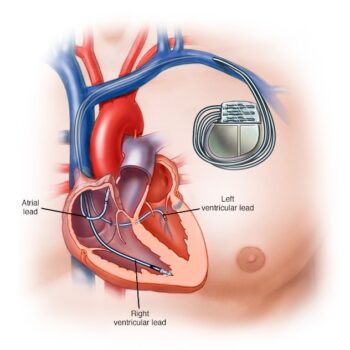Pacemakers are electronic devices that’s placed under the skin in your chest to stimulate the heart with electrical impulses to maintain or restore a normal heartbeat. Implanting a pacemaker in your chest requires a minimal surgical procedure.
Cardiac devices

Implantable cardioverter defibrillator: An ICD is a small device which can treat people with dangerously abnormal heart rhythms. It sends electrical pulses to regulate abnormal heart rhythms, specifically those that can be dangerous and cause a cardiac arrest.
Cardiac resynchronization therapy is a procedure to implant a device in your chest to make your heart’s chambers squeeze (contract) in a more organized and efficient way. CRT is a minor surgical procedure to implant an electronic device under the skin. The device helps coordinate the timing of the contraction of the heart’s lower chambers (ventricles), and improves the heart’s pumping function.
What are the side effects of having a pacemaker?
Complications from surgery to implant your pacemaker are uncommon, but could include:
-
- Infectionwhere the pacemaker was implanted.
- Allergic reaction to the dye or anesthesia used during your procedure.
- Swelling, bruisingor bleeding at the generator site, especially if you take blood thinners
What are the signs of needing a pacemaker?
- Fatigue, dizziness, lightheadedness, fainting, and the inability to exercise without getting out of breath are all potential signs of needing a pacemaker
- ECG and holter monitoring showing abnormal pattern or changes
Post Pacemakers procedure: dos and don’ts
- Do let the DVLA and your car insurance company know you have one.
- Do use a mobile or cordless phone if you want, but use the ear on the opposite side to the pacemaker.
- Do keep MP3 players at least 15cm (6in) from your pacemaker.
- Don’t use an induction hob if it is less than 60cm (2 feet) from your pacemaker.
- Don’t put anything with a magnet within 15cm (6in) of your pacemaker.
- Don’t linger for too long in shop doorways with anti-theft systems, although walking through them is fine.
- Do walk through security screening at airports, but make sure you have your ID card with you, as the alarm is likely to go off.
- Don’t stand close to airport security screening for too long and, if someone checks you with a handheld scanner, ask them not to hold it over your pacemaker.
